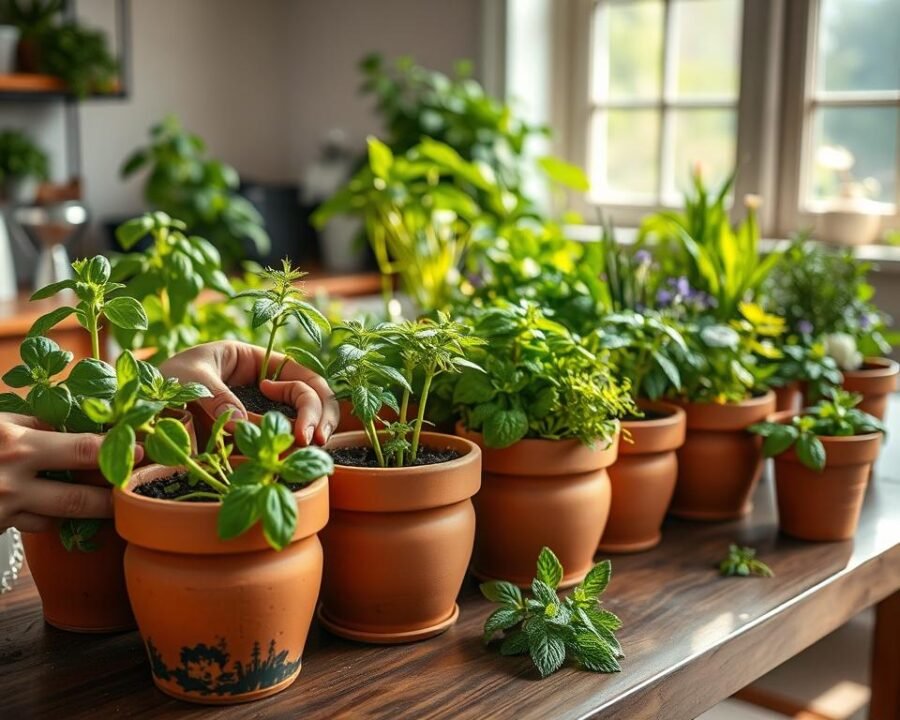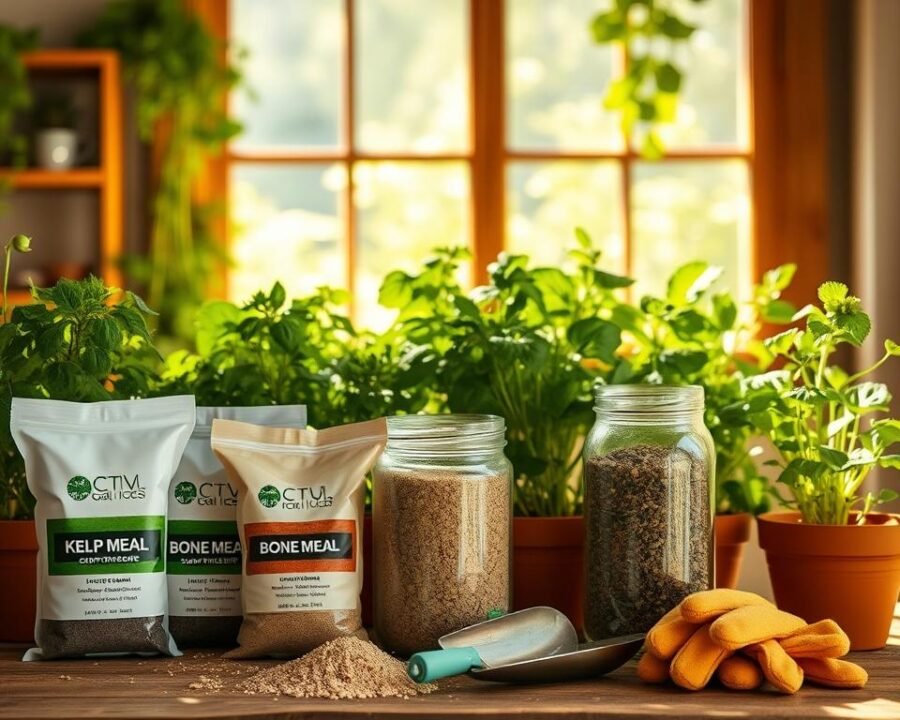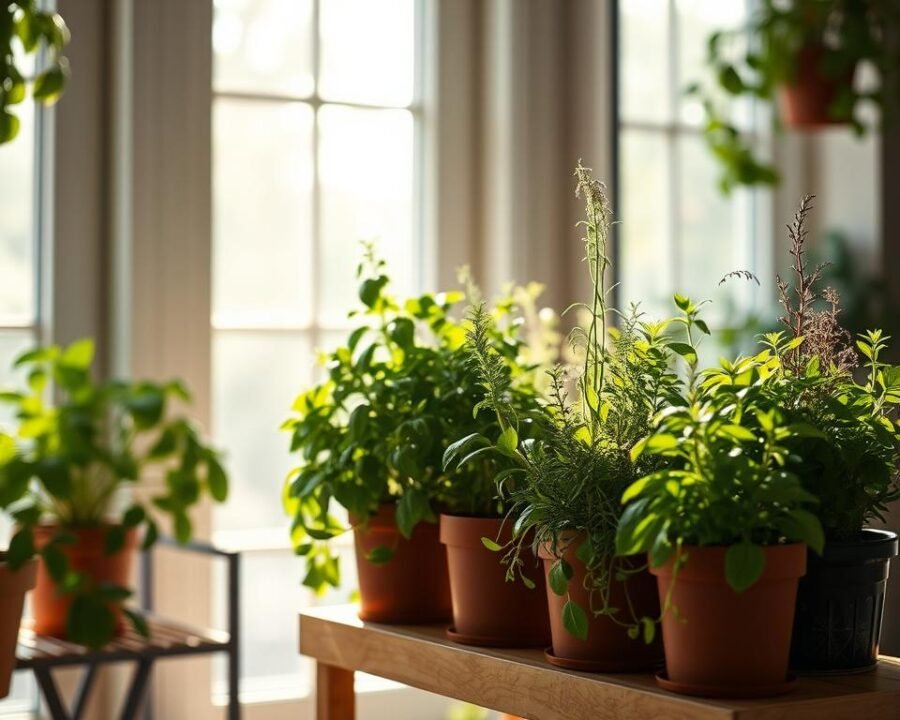Learn with Us how to grow how to plant indoor herbs everyone is using
There’s something magical about snipping fresh basil for pasta or garnishing a dish with homegrown cilantro. No matter the season, having a garden right in your kitchen brings joy and convenience. Even in small apartments, a few pots of vibrant herbs can thrive with the right care.
We believe everyone deserves access to fresh, flavorful ingredients. Whether you’re a seasoned gardener or just starting, cultivating plants indoors is rewarding and simple. With proper lighting and a little attention, you’ll enjoy aromatic greens year-round.
From basil to thyme, we’ll walk you through selecting the best varieties, setting up your space, and avoiding common pitfalls. Let’s turn your home into a lush, sustainable oasis—one pot at a time.
Key Takeaways
- Enjoy fresh herbs all year, no outdoor space needed.
- Perfect for apartments, kitchens, or sunny windowsills.
- Save money compared to store-bought options.
- Simple steps ensure success, even for beginners.
- Enhance meals with homegrown flavors.
Why Grow Indoor Herbs? Fresh Flavors Year-Round
Fresh herbs elevate every dish with vibrant flavors and aromas. Unlike dried supermarket versions, homegrown leaves pack three times the potency. A single snip of basil or thyme transforms soups, salads, and sauces.
Beyond cooking, these plants offer surprising perks. Studies show tending to greenery reduces stress for 68% of gardeners. Fragrant varieties like lavender or rosemary double as natural air fresheners.
Here’s why a kitchen garden is worth the space:
- Save money: Skip $3.50 supermarket bunches; grow your own.
- Boost wellness: Mint aids digestion; basil has anti-inflammatory properties.
- Pet-safe picks: Catnip for feline friends or parsley for dogs.
Get creative with surplus harvests. Steep mint leaves for tea, infuse olive oil with rosemary, or dry sage for DIY potpourri. Even varieties like purple basil add pops of color to your space.
Whether you crave culinary zest or a calming hobby, indoor herbs deliver. Start small, and let nature’s flavors thrive on your windowsill.
How to Grow How to Plant Indoor Herbs Everyone Is Using
Nothing beats the aroma of freshly picked thyme or basil from your own mini garden. Whether you’re working with a sunny windowsill or a cozy corner, selecting the right varieties and tools sets the stage for success.
Choosing the Right Herbs for Your Space
Herbs grow differently—some spread wildly, while others stay neat. Mint, for example, needs a wide container to accommodate its roots. Compact varieties like thyme or oregano fit snugly in small pots.
Consider these growth habits:
- Bushy: Basil, parsley (6–8″ pots)
- Trailing: Creeping thyme (hanging baskets)
- Compact: Chives, dwarf rosemary (4–6″ pots)
| Herb | Pot Diameter | Depth |
|---|---|---|
| Basil | 8–10 inches | 8 inches |
| Mint | 12+ inches | 10 inches |
| Thyme | 6 inches | 6 inches |
Essential Supplies: Pots, Soil, and Tools
Start with quality soil. Miracle-Gro® Indoor Potting Mix ensures proper drainage, critical for healthy roots. Avoid garden soil—it often harbors pests.
Pro tip: Repurpose yogurt containers with drilled holes for a budget-friendly pot. Pair with these tools:
- Pruning snips for tidy harvests
- Moisture meter to prevent overwatering
- Spray bottle for gentle hydration
For sustainable gardening practices, blend perlite into your mix (1:3 ratio) for aeration. Learn more about eco-friendly setups here.
Shopping List for Beginners:
- Bonnie Plants® starter herbs
- Ceramic or self-watering pots
- Vermiculite (for moisture retention)
Finding the Perfect Spot for Your Indoor Herb Garden
Position matters—your herbs’ vitality depends on their spot in your home. Even with the best soil and care, insufficient light leads to leggy stems and pale leaves. Let’s map out the ideal locations for robust growth.
South- or West-Facing Windows: Best for Sun-Loving Herbs
South-facing windows bathe plants in all-day sun, perfect for basil, rosemary, and thyme. West-facing spots offer intense afternoon rays—great for oregano but may scorch delicate parsley. Rotate pots weekly for even exposure.
Pro tip: Use a free app like Lux Light Meter to measure intensity. Aim for 10,000–20,000 lux for Mediterranean herbs.
North- or East-Facing Windows: Ideal for Low-Light Varieties
Morning light from east windows suits mint and chives. North-facing sills work for shade-tolerant parsley or cilantro. In winter, supplement with reflective foil behind pots to bounce available light.
Using Grow Lights for Extra Boost
No sunny space? LED clip-ons (12–14 hours/day) mimic natural sun. Full-spectrum bulbs cost just $0.50/month to run. Here’s a comparison:
| Light Type | Cost/Month | Best For |
|---|---|---|
| LED Strip | $0.40 | Small herbs (thyme, oregano) |
| CFL Bulb | $0.60 | Bushy plants (basil, mint) |
| HID Fixture | $1.20 | Large setups (rosemary, sage) |
Dark apartment fixes: Try these low-light champs:
- Lemon balm
- Chervil
- Vietnamese coriander
Adjust setups seasonally—shorter days in winter demand longer artificial light periods. Watch for leaf burn near hot west windows and move sensitive plants back a few inches.
Planting Your Indoor Herbs: Step-by-Step
Success starts below the surface—healthy roots mean happy plants. Whether you’re sowing seeds or transplanting starters, the right techniques ensure lush growth. Let’s dig into the essentials.

Selecting Seeds vs. Starter Plants
Bonnie Plants® starters mature 3–4 weeks faster than seeds—ideal for impatient cooks. But sowing seeds offers cost savings and rare varieties like lemon basil. Compare these germination rates:
- Basil: 5–10 days
- Parsley: 14–28 days (soak overnight to speed up)
- Chives: 7–14 days
For beginners, we recommend starter plants. Their established roots adapt quicker to container life.
Potting Mix and Drainage Tips
Use quality potting mix—Miracle-Gro® Indoor Potting Mix prevents compaction. Clay pots dry faster than plastic, reducing overwatering risks. Always check for drainage holes!
Pro tip: Skip gravel layers—they trap water. Instead, place coffee filters over holes to keep soil in. Test drainage with this trick:
- Water until it runs from the bottom.
- If pools form after 15 minutes, add perlite.
Spot poor drainage early: moldy soil, foul odors, or standing water. Repot if needed, but avoid oversized containers—herbs prefer snug spaces.
Watering Indoor Herbs the Right Way
The secret to thriving potted greens lies in mastering hydration—too much or too little spells trouble. While mint craves constantly moist soil, Mediterranean varieties like rosemary prefer drying out between drinks. We’ll help you decode your plants’ silent language.
Tailoring Water Schedules by Herb Type
Use this cheat sheet to prevent guesswork:
- Daily: Mint (keep soil damp)
- Every 3 days: Basil, parsley (top inch dry)
- Weekly: Thyme, oregano (bone-dry between)
Pro tip: The lift test never lies. A light pot needs water; a heavy one signals excess moisture. For precision, XLUX Soil Moisture Meter ($12.99) gives digital readings.
Reading Your Plants’ Distress Signals
Drooping leaves can mean opposite issues. Check these clues:
- Overwatered: Yellow leaves + mushy stems
- Underwatered: Crispy edges + curled foliage
Revive drowned basil by repotting in fresh mix. For parched plants, soak the pot in a tray for 20 minutes.
“Wilting often means roots are drowning, not thirsty. Always check soil before reaching for the watering can.”
Travel-proof solutions:
- Wick systems using cotton cords
- Terracotta spike waterers
- Plastic bottle drip feeders
Adjust routines seasonally—herbs drink slower in winter. Group humidity-lovers like basil on pebble trays to mimic tropical air.
Feeding Your Herbs for Optimal Growth
Nourishing your potted greens makes all the difference between sparse sprigs and lush harvests. While sunlight and water get most attention, fertilizer is the silent hero for vibrant leaves and intense flavors. We’ll help you decode nutrient needs without overwhelming your plants.

Best Fertilizers for Indoor Herbs
Organic options like fish emulsion release nutrients slowly, preventing burn. Synthetic choices like Miracle-Gro® Water Soluble Plant Food offer precise N-P-K ratios. Consider these pros:
- Organic: Improves soil health (compost tea recipe below)
- Synthetic: Fast-acting for quick growth spurts
How Often to Fertilize
Mediterranean herbs like rosemary need half-strength feeds monthly. Basil and parsley crave biweekly meals during peak growth. Winter demands minimal feeding—think “light snacks” versus summer “feasts”.
| Season | Frequency | Dilution |
|---|---|---|
| Spring | Every 2 weeks | Full strength |
| Summer | Weekly | ¾ strength |
| Fall/Winter | Monthly | ¼ strength |
DIY compost tea: Steep 1 cup compost in 1 gallon water for 48 hours. Strain and use within 4 hours for maximum microbial benefits.
Spot overfeeding with these warnings:
- White crust on soil surface
- Brown leaf tips
- Sudden leaf drop
“Less is more with herbs—overfed plants produce bland flavors. When in doubt, dilute your fertilizer by 50%.”
Pruning and Harvesting for Continuous Growth
Smart snipping keeps your herbs lush and productive. Unlike outdoor gardens, indoor plants rely on strategic pruning to prevent legginess. Done right, each cut stimulates new growth while preserving the plant’s vitality.
How to Trim Without Harming the Plant
Always cut above leaf nodes—the small bumps where leaves emerge. This way, the plant redirects energy to side shoots, creating bushier growth. Avoid blunt scissors; sharp snips prevent ragged tears that invite disease.
Follow the “1/3 rule”:
- Never remove more than one-third of foliage at once
- Focus on older stems near the base
- Angle cuts downward to shed water
When and How to Harvest
Morning is prime time—leaves hold the highest oil content then. For basil, pinch stems just above two new leaves. Woody herbs like rosemary need clean cuts with bypass pruners.
| Herb | Best Harvest Time | Method |
|---|---|---|
| Basil | Before flowering | Pinch stems |
| Mint | When 6″ tall | Cut above 2nd leaf set |
| Thyme | Mid-morning | Snip woody stems |
Preserve extras by:
- Freezing in ice cube trays with water
- Hanging bundles upside-down to air-dry
- Making herb-infused vinegars
“Regular harvesting is like giving your plants a haircut—it keeps them healthy and productive all season.”
Watch for flowering, which often reduces flavor. For perpetual basil, pinch off flower buds immediately. Most culinary herbs peak just before blooming.
With these techniques, your kitchen garden becomes a self-renewing resource. A little care goes a long way toward endless fresh flavors.
Troubleshooting Common Indoor Herb Problems
Even the healthiest herb garden can face challenges—but solutions are simpler than you think. Most issues stem from just a few factors: inadequate light, watering mishaps, or uninvited pests. We’ll help you diagnose and fix problems before they escalate.
Leggy Growth: Fixing Insufficient Light
When stems stretch awkwardly with sparse leaves, your plants crave more sunshine. Mediterranean varieties like rosemary show this first. Try these fixes:
- Move pots within 12 inches of south-facing windows
- Supplement with full-spectrum LED grow lights (12 hours/day)
- Rotate pots 180° every 3 days for even exposure
For severe cases, prune leggy stems back to 4 inches. New growth will emerge bushier. Winter often demands light adjustments—shorter days may require extending artificial lighting to 14 hours.
Pests and Diseases to Watch For
Aphids love tender basil, while spider mites target stressed plants. Powdery mildew appears as white dust on leaves. Combat these naturally:
- Neem oil spray (2 tbsp/gal water) weekly for 3 weeks
- Sticky traps for flying insects
- Cinnamon dust on soil to deter fungus
“Quarantine new herbs for 2 weeks. Many pests hitchhike on store-bought plants.”
Our mint rescue case: Isolate infested plants, rinse with water, then apply insecticidal soap. Repeat every 5 days until pests vanish. Prevent future outbreaks by maintaining 40-50% humidity—too dry invites mites, too damp encourages mold.
With quick action and these organic solutions, your herbs will rebound stronger. Remember, stressed plants recover faster when handled minimally—observe first, then intervene thoughtfully.
Top Herbs to Grow Indoors (and Their Care Tips)
A pinch of fresh basil or a sprig of rosemary can transform ordinary meals into culinary delights. We’ve curated the best varieties for windowsill gardens, complete with foolproof care guides.
Basil, Mint, and Parsley: Easy Favorites
Basil thrives in warm spots (70°F+) and needs frequent harvesting to prevent flowering. Try ‘Genovese’ for pesto or ‘Purple Ruffled’ for color. Keep soil moist but never soggy.
Mint demands space—its roots spread aggressively. Plant in wide containers and trim regularly. For unique flavors, experiment with chocolate or pineapple varieties.
| Herb | Light Needs | Water Frequency |
|---|---|---|
| Basil | 6+ hours sun | Every 2-3 days |
| Mint | 4 hours sun | Keep damp |
| Parsley | Bright indirect | When top inch dries |
“Prune mint weekly to control growth. Those vigorous roots can overtake neighboring plants if unchecked.”
Rosemary and Thyme: Sun-Loving Staples
Mediterranean herbs like rosemary and thyme crave sunlight. South-facing windows are ideal. ‘Berggarten’ sage makes an excellent companion with similar needs.
Propagate thyme by snipping 3-inch stems and rooting in water. These woody herbs prefer:
- Well-draining soil with extra perlite
- Infrequent deep watering
- Monthly diluted fertilizer
For pest-resistant options, prioritize:
- Greek oregano (deters aphids)
- Lemon balm (repels whiteflies)
- Chives (naturally antifungal)
Pair these flavors like a pro:
- Rosemary: Roasted potatoes, lamb
- Thyme: Soups, roasted vegetables
- Parsley: Tabouli, fish dishes
Creative Ways to Use Your Homegrown Herbs
Your windowsill garden offers more than just fresh flavors—it’s a springboard for culinary adventures and crafty projects. With a little creativity, those vibrant leaves can transform everyday dishes and self-care routines.

Elevate Everyday Cooking
Fresh herbs pack triple the flavor of dried versions—use just 1/3 the amount in recipes. Try these simple upgrades:
- Summer salads: Toss watermelon with mint and feta
- Morning eggs: Fold chives into scrambles
- Grilled dishes: Rosemary skewers for kebabs
“Infuse honey with thyme for a sweet-savory drizzle perfect over cheeses or roasted carrots.”
Our award-winning pesto recipe combines:
- 2 cups fresh basil
- 1/2 cup pine nuts
- 1 lemon‘s zest
- 1 garlic clove
Craft Herb-Infused Creations
Preserve your harvest with these ways:
| Method | Best Herbs | Shelf Life |
|---|---|---|
| Oil infusion | Rosemary, thyme | 1 month refrigerated |
| Ice cubes | Mint, basil | 6 months frozen |
For gifting ideas:
- Lavender sachets for drawers
- Herbal bath salts with chamomile
- Dried wreaths with sage and bay leaves
The Miracle-Gro Twelve™ system even lets you grow hydroponic basil for year-round infusions. Just remember—when making oils, always:
- Use completely dry herbs
- Store in dark bottles
- Label with dates
From lemon verbena tea to rosemary shortbread, your homegrown bounty offers endless possibilities. What will you create first?
Conclusion: Enjoy Your Thriving Indoor Herb Garden
Your journey to a lush kitchen garden starts with small steps. Remember the essentials—ample light, proper drainage, and regular pruning. These simple habits keep plants vibrant and productive.
Start with one or two pots of basil or mint. As confidence grows, expand your collection. Join our 30-day challenge—track progress and share wins with local gardening groups.
Seasonal shifts matter. Rotate plants for optimal sunlight in winter. Download our care sheets for quick reminders. Submit photos of your setup for a chance to be featured!
“Gardening is the art that uses flowers and herbs as paint, and the soil and sky as canvas.” — Tovah Martin
With patience and care, your garden will flourish. Fresh flavors await—one snip at a time.







